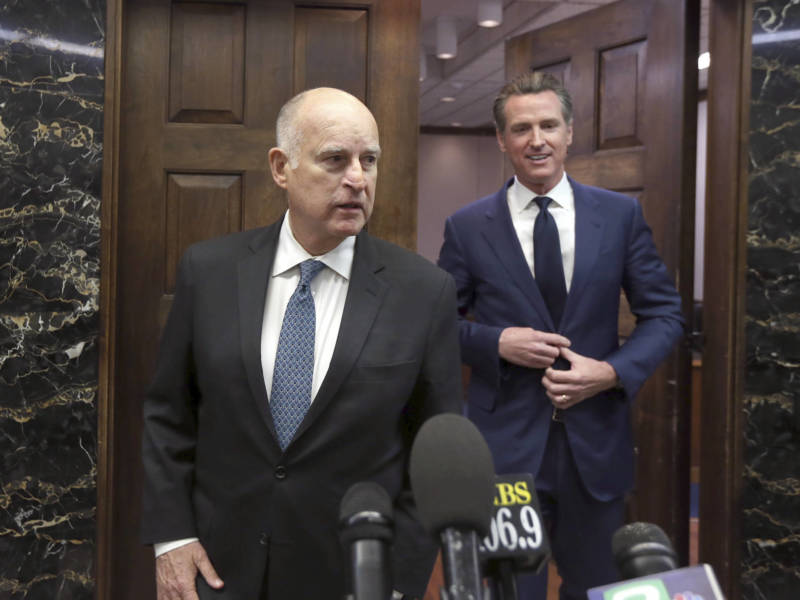“We’re building on a lot of the work that’s been done,” he said in a brief interview after the speech. “We’re just being more sober about it, more deliberative about it, more focused, more transparent.”
At this early stage in his governorship, here are five key ways Newsom has sought to differentiate himself:
Border Patrol
Early last year, President Trump asked border-state governors to beef up their National Guard troops along the Mexican border. Brown responded by saying California troops wouldn’t enforce immigration laws or “build a new wall.” But he agreed to add 400 troops, saying they would focus on combating transnational crime.
Newsom rolled back Brown’s order this week, reassigning most of the troops from the border to areas threatened by wildfire and illegal marijuana grows. Those remaining at the border “will focus on stopping criminals smuggling drugs and guns through existing border checkpoints,” Newsom said in his speech. “This is our answer to the White House: No more division, no more xenophobia and no more nativism.”
High-speed rail
Since his first stint as governor in the 1970s, Brown has advocated for a new high-speed train to connect Northern and Southern California. He took steps more recently to support the project by negotiating funding for it from California’s signature climate change program. “I make no bones about it,” Brown said last year. “I like trains, and I like high-speed trains even better.”
Newsom said Tuesday that he has “nothing but respect for Governor Brown’s and Governor Schwarzenegger’s ambitious vision.” But he derided the current plan for a train from San Francisco to Los Angeles, saying it “would cost too much and take too long.”
Instead, Newsom embraced a more limited rail line, from Merced to Bakersfield. He also announced a new chairman for the rail authority, Lenny Mendonca, and a plan to post rail spending publicly online, a step meant to hold the administration accountable for cost overruns.
Republicans, long opposed to the new train, welcomed Newsom’s tack. State Sen. Shannon Grove of Bakersfield, who will soon take over as the Senate Republican leader, thanked Newsom for scaling back the project and making spending on it more transparent. “That was very responsible,” she said. “I’m pleasantly surprised.”
Water
Newsom also wants to scale back Brown’s controversial plan to carve two massive tunnels through the Sacramento-San Joaquin Delta to move water to Southern California. Instead, as he said during the campaign, and reiterated in his speech, he wants to build one tunnel.
The idea was quickly embraced by Assembly Speaker Anthony Rendon, who said, “I’ve been skeptical of the two-tunnel approach for a while. Rethinking it and retooling it makes a lot of sense.”
To help carry out Newsom’s vision, the governor appointed Joaquin Esquivel as the new chair of the state water board, replacing Brown’s pick, Felicia Marcus.
Education
Newsom and Brown have very different views when it comes to keeping track of how students are performing in California’s public schools. Brown repeatedly rejected the idea of developing a database to track student performance over time, saying he disagreed with a focus on test scores and feared the data could be abused to support prejudice. Newsom is embracing a long-term student database as a way to measure which programs advance student learning.
“We need clear and achievable standards of transparency, more information sharing, and accountability for all public schools,” he said in his speech.
Newsom used the speech to announce his pick to lead the state Board of Education, naming Linda Darling-Hammond to the post. A former Stanford professor, she is an expert in teacher training and has chaired the state’s Commission on Teacher Credentialing for the last eight years.
Housing & homelessness
Tackling California’s extraordinarily high cost of housing — and the related epidemic of homelessness — was never a top priority for Brown. Even as he left office, he said he didn’t think there was much the state could do to make homes more affordable.
Newsom wants to change that by holding cities accountable for building affordable housing. He already sued the city of Huntington Beach for not building enough, and said in his speech that he wants to meet with 47 other cities that aren’t meeting their housing requirements.
Newsom also announced that he is establishing a new commission on homelessness, to be led by Sacramento Mayor Darrell Steinberg.
CALmatters.org is a nonprofit, nonpartisan media venture explaining California policies and politics.
